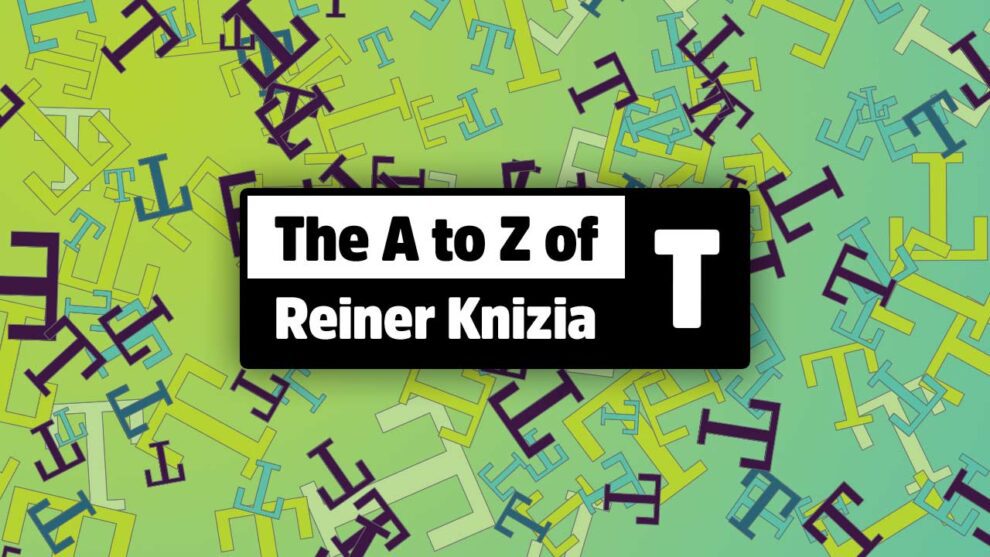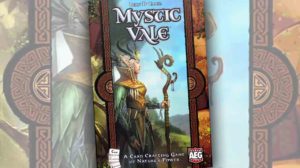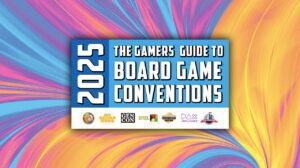The year 2025 marks the 40th anniversary of Dr Reiner Knizia’s career as a board game designer – his first published game, Complica, was released in a magazine in 1985 (although he’d self-published games before then as well).
Since then, Knizia has designed and published over 800 games and expansions, many of which are critically acclaimed. Put simply, Reiner Knizia is the landscape on which all other modern designers build their houses.
To celebrate Knizia’s career and back catalogue, Meeple Mountain are taking things back to basics to consider the ABC of Reiner Knizia: one game for each of the 26 letters of the alphabet.
This time: The Letter ‘T’.
T – Through the Desert (1998)
Knizia is famously reticent when it comes to naming a favourite design of his (although, as in this recent interview with Game Market, he’s sometimes happy to name games that he’s proud of). His stock response in interviews to the ‘favourite game’ question is that it’s “very difficult to pick out my favourite game, it is almost like picking out your favourite child”. When pushed for an answer, he’ll then remark that “if you have over 500 kids it gets much more complicated”. Finally, Knizia will say that his “favourite games are the ones that [he’s] currently designing”.
However, whilst he doesn’t have a favourite (or at least doesn’t admit to having one), there is one game that he feels epitomises ‘Dr Reiner Knizia’: Through the Desert.
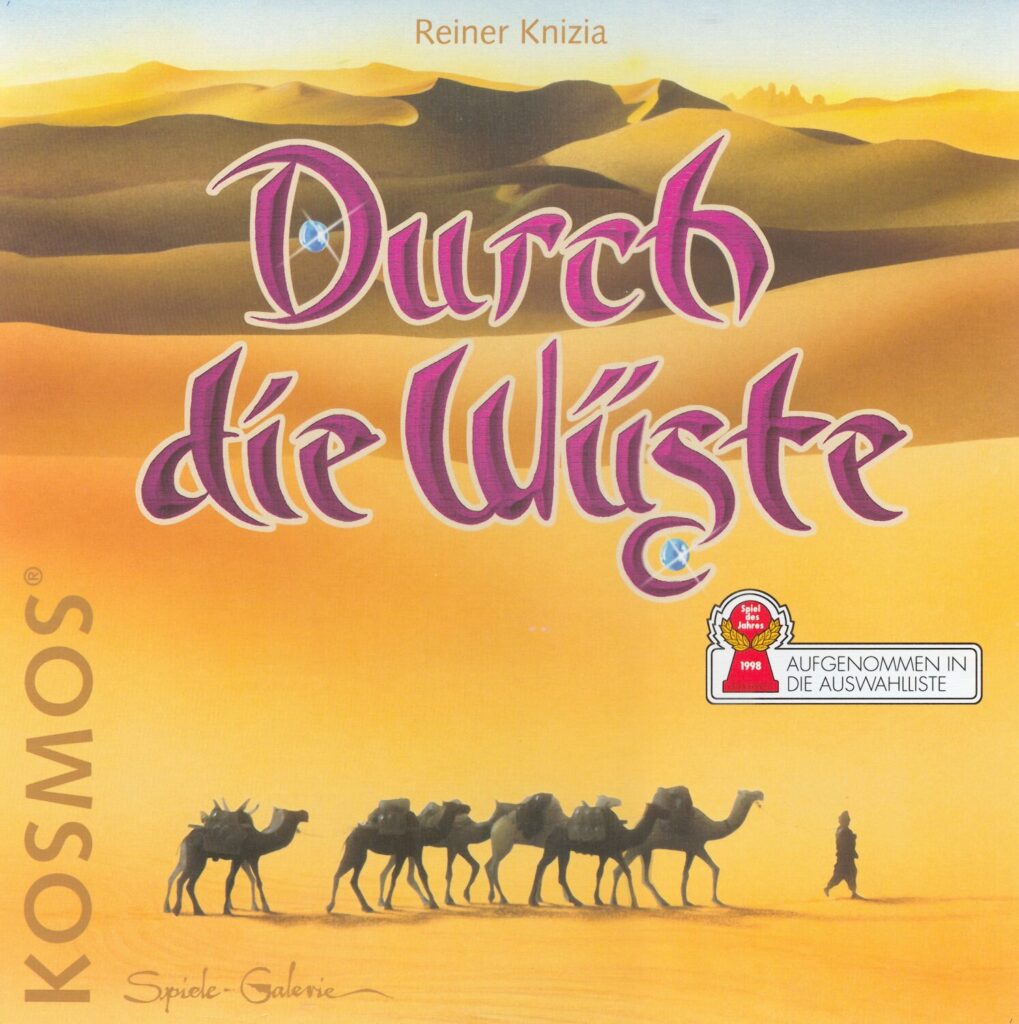
Part of Knizia’s late-90’s unintentional tile-laying trilogy, Through the Desert is a game of extending camel trains across an increasingly tight map, aiming to claim oases, waterholes and entire patches of desert. Each player has five separate camel caravans and on a turn you can add two camels to extend one or two of your caravans.
This is the cleverness behind Through the Desert. With the board liberally dotted with points, there are so many things you could aim to do but somehow you’ve got to juggle all five of your camel trains and the five trains that each other player also has and is extending. The board starts busy and just gets tighter and more cramped as the game goes on, especially since camels of the same colour but belonging to different players can’t be placed next to each other.
Whilst it sounds overwhelming and hard to keep track of, the simplicity of what you’re doing each turn (placing two camels) means that your entire focus can be on the board and those creeping camel chains. Even the use of colour, which seems like it might be confusing (five colours of camels with additional player colour riders on each starting camel), fades into the background, although the game does present problems for those who are colourblind (as AllPlay document in this update).
It’s a very clever game and that perhaps stems from Knizia’s interests at the time.
If you remember from our discussion of the Letter S and Samurai, in the mid to late nineties Knizia was getting interested in Eastern culture and design philosophies. Released in 1998, the same year as Samurai, Through the Desert has been referred to as a modern interpretation of Go, with its mix of territorial control and chains of pieces. In actual fact the similarity is coincidental (or subconscious), and was only pointed out by a Go player during playtesting.
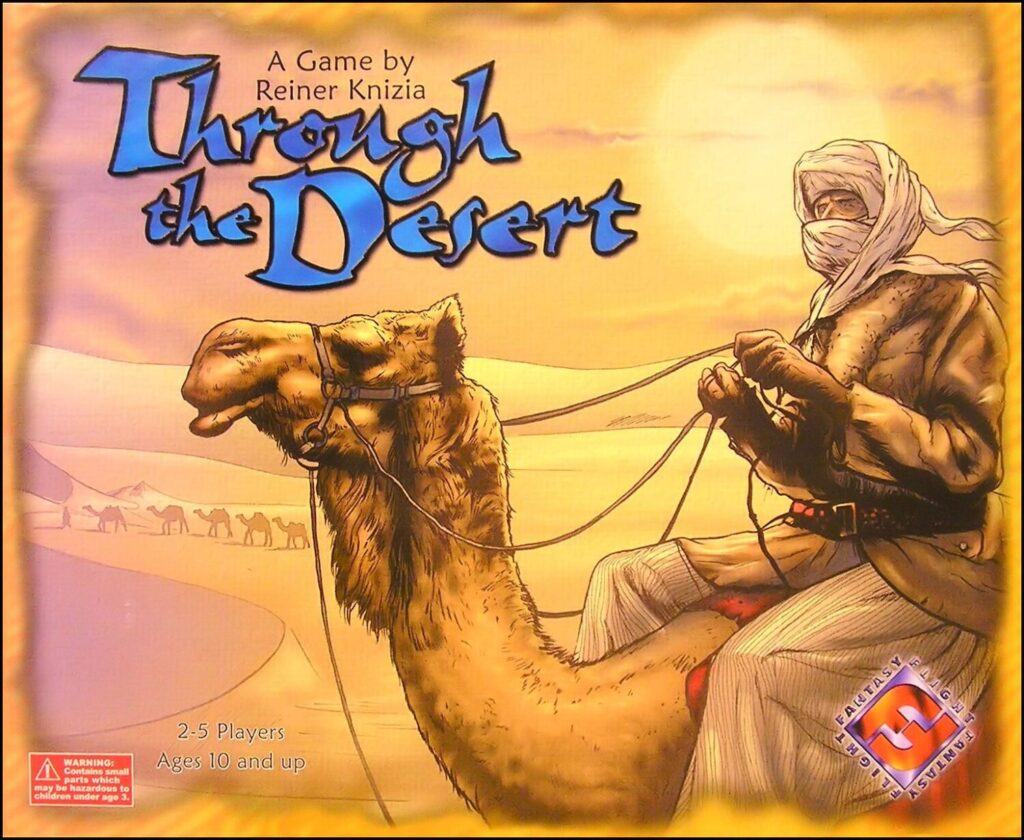
The similarity to one of the all time great traditional abstract games is also apparent in the theme – unlike its trilogy stablemates, this is not a highly thematic experience. “When I’m teaching games, I always start with a thematic sales pitch,” says Quentin Smith of Shut Up and Sit Down, “with Through the Desert, that just had to stop. We’re not actually going through the desert, we’re kind of going around it… mostly we just want water? They probably should have called it Reiner Knizia’s Thirsty Twerps.” Through the Desert may boast some glorious components (those camel pieces!) but it’s a purely abstract experience. It wasn’t always, however.
The original title for the game was ‘Rockefeller: Second to None’ and it was about wealthy families competing on an island for the best status symbols, including golf courses, houses and museums. Knizia had started the design in 1996, but during development he felt that he had to make changes to the gameplay. “I saw that the theme was no longer in sync with the mechanics,” he said in 2000 on the Board Game Show, “so I started thinking about where could that game take me and finally it took me into the desert”. It was publisher KOSMOS who came up with the camel/desert setting, feeling it was more marketable. “I thought about it,” said Knizia to Funagain, “decided it was something I could live with, and we went with it.” One wonders whether the satirical anti-rich theme of the original theme came from the same thought-seam as High Society which had been released the year before he started designing Through the Desert (see the Letter H for an in-depth discussion of Knizia’s use of satire).
As some have argued, and as we discussed with the trilogy’s third member way back with the Letter E, Knizia is a master of incorporating theme into many of his most well-regarded games. Through the Desert is a bit of an odd duck, the feelings and emotions evoked by its gameplay completely unrelated to the oases, camels and sand. And yet this is the one game he refers to reliably in interviews across the decades as the game he feels best epitomises himself. Why?
It comes down to his personal philosophy of life.
“Life is a game,” said Knizia in that 2002 Funagain interview, “and there’s so much to do and so few turns… you have the rich choice of what you want to do next – saying ‘yes’ to one thing means saying ‘no’ to another thing. I think that’s really the essence of Through the Desert, where you know you want to do so many things, but you can’t do them all and you have to choose.”
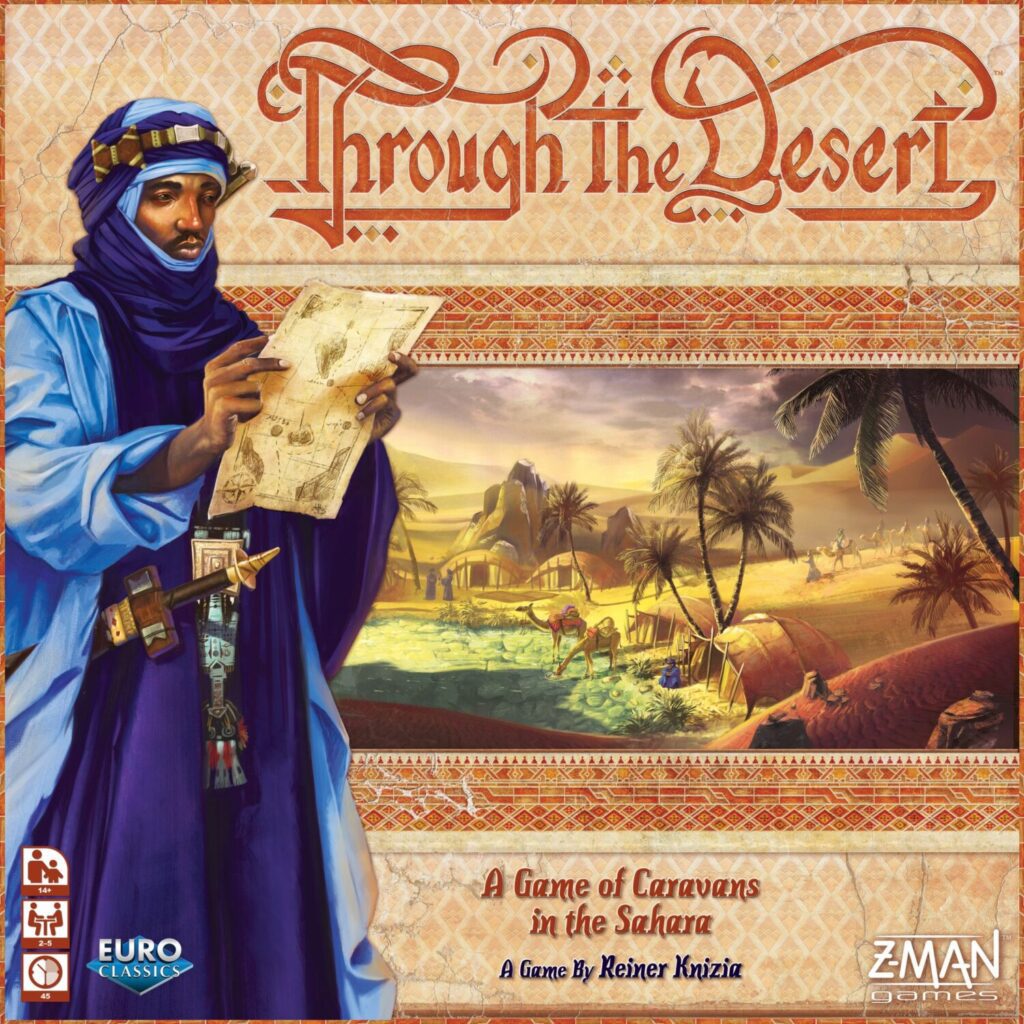
Twenty years later he still felt the same, although his life seems to have improved further. “If I look at my life,” he said on the 5 Games to Doomsday podcast in 2022, “I see that my life is overfilled with exciting things and I just have to take very painful choices almost every day – what of these great things can I do and what do I have to say no to? I want to find the same situation and the same feeling in the game, I want to sit there biting my fingernails, I want to do 12 moves but I can only do 2.”
There are other ways that Through the Desert represents Knizian game design as well. “Perhaps more than any of his other 800 releases, Through the Desert epitomizes the strengths of Reiner Knizia,” says Nick Murray of Bitewing Games, “Simple rules. Tight interactions. Basic actions that are merely the tiny tip of a strategic iceberg… Few things are as satisfying as placing a camel on a hex to further your plans and inflict pain on others.”
Smith is more colourful in his description of weighing up getting points against edging out your opponents. “You know you’ve gotten this balance right when the claiming of a single space with a single teeny camel causes a calamitous cry of “F**K” from one of your opponents because they KNEW they should have claimed that LAST TURN and they DIDN’T.”
It’s the choices tempting you each turn that critics often rave about, something that Knizia himself is proud of. “The pleasure is that you can win in many different ways,” he said at the release of the first English edition in 2000, “but you cannot take a single strategy on one type of scoring and hope to get ahead”. Meeple Mountain’s own Andrew Lynch agrees. “A good game of Through the Desert constantly forces you to choose between priorities,” he says in his review of Through the Desert, “to decide which position to develop, to abandon certain caravans to the blows of the sun’s anvil. It is tense, it is brutal, it is often funny, and it’s over within 20-25 minutes.”
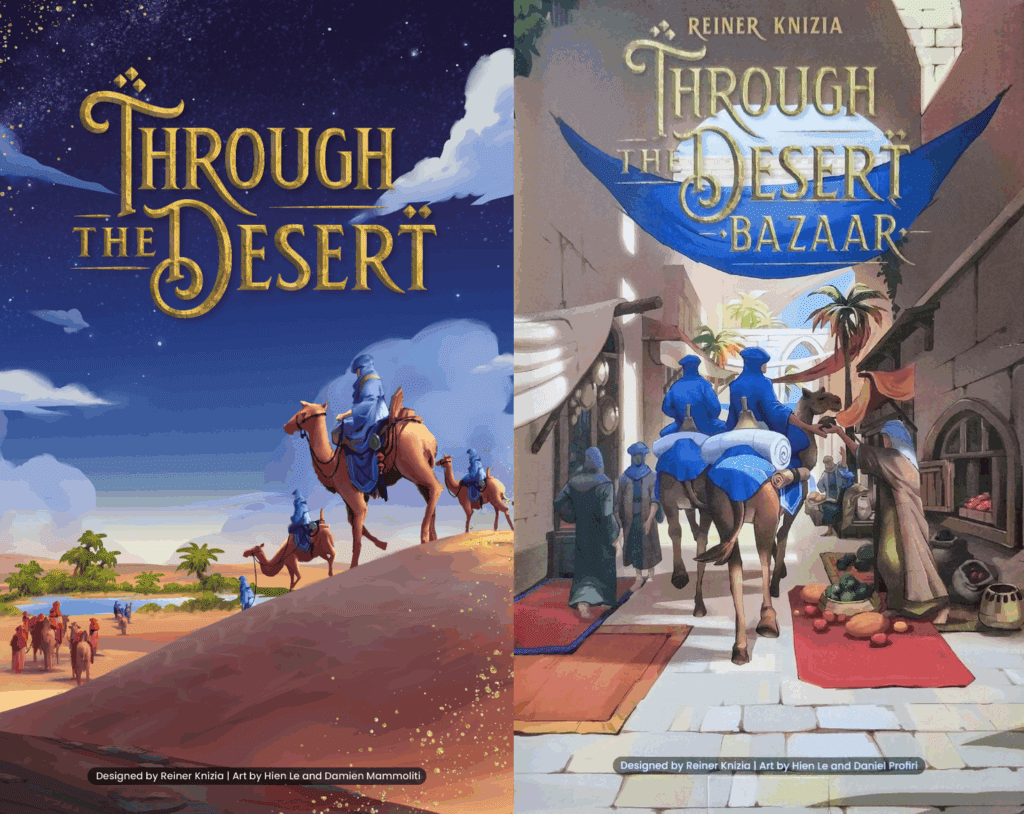
The result is a critical and player darling, a game that has been well respected since its release. It was nominated in 1998 for the Spiel des Jahres awards, alongside Knizia’s own Tigris & Euphrates. Sadly, both lost out to Elfenland at the awards (see our discussion of the Letter K for further details of this Knizian injustice) but that hasn’t stopped the critical acclaim.
“This game is absolutely phenomenal,” said Smith, back in 2018 reviewing Z-Man’s ‘Euro Classics’ mid-2010’s reprint. Launched in 2015 with a reprint of Tigris & Euphrates, the Euro Classics line was the brainchild of Fantasy Flight Games’ founder Christian T. Petersen and included Samurai, Ra, Through the Desert and, lastly, Taj Mahal. Unfortunately, changing publisher priorities and the rise of crowdfunding meant that the Euro Classics line was discontinued in 2021, including the scrapping of all progress on Wolfgang Kramer’s Princes of Florence, the sixth title (and first non-Knizian game) planned for the series. In his ‘Ode to the Euro Classics’, then Head of Z-Man Studio Steven Kimball went on to predict the recent spate of Knizia crowdfunding reprints whilst acknowledging the importance of the tabletop media in an increasingly busy market (and even included an affectionate dig at Smith and the Shut Up and Sit Down team’s ‘poshly articulated’ Queen’s English!).
As Kimball predicted, the 2020s have seen many classic Knizia games being reprinted via crowdfunding. In 2023 publisher AllPlay successfully funded a reprint of Through the Desert, alongside its first expansion: Bazaar. The new expansion features four minor tweaks to the game, introducing djinns, special waterholes, nomads and the titular bazaars. None of them dramatically alter the game, but if you’ve been playing Through the Desert for 25 years then some minor additions might be appreciated!
Taking a Tour of Tantalising ‘T’s
There are tons of ‘T’ treats from the talented game technician’s time designing. Here are some we’d like to tag:
Taj Mahal – The only member of Z-Man Games’ short lived run of ‘Euro Classics’ not to be a main feature in our Knizia alphabet, Taj Mahal is a classic design from 2000. Taj Mahal is an auction design that sees players building palaces across northern India. The bidding in Taj Mahal is one of Knizia’s most interesting auction systems, with multiple items and abilities up for grabs in a single auction and the ability to withdraw from an auction at a critical moment to claim anything you currently have the majority in. It’s tight, timing is important and the scoring can feel opaque but it’s definitely worth a visit. “It may not be his most popular classic design,” says Nick Murray of Bitewing Games, “but I believe that Taj Mahal is low-key one of his best.” Knizia is apparently shopping the design around so here’s hoping a new version is announced in the next year or so.
Tajuto – Is it a bit weird that players in Tajuto are Buddhist monks competing to be the most spiritual? Quite possibly – it doesn’t seem to gel with Buddhism’s focus on mutual growth and self-improvement – but some have argued that Tajuto actually embodies some of Buddhism’s core tenents. Tajuto sees players pulling coloured floors from a bag to communally build four tajutos (pagodas) for a Japanese prince in the 6th Century. “Tajuto might be one of Reiner Knizia’s most underrated designs, ever,” says Murray, a big Knizia fan, “it offers uniquely thrilling moments of push-your-luck drama… Pulling out the perfect piece feels like pulling a rabbit out of a hat — pure magic.” Meeple Mountain’s Tom Franklin is less convinced. “There are elements that I enjoy,” he says in his review of Tajuto, “there are parts that continue to bother me, and there are things that just don’t work for me at all”.

Tatari – Quite possibly the creepiest of all of Knizia’s games, 2022’s Tatari comes from the same family as 2014’s Zombie Mania! but dials up both the gameplay and creep-factor. It’s a simple game of trying to rid yourself of cursed Japanese dolls by rolling the right numbers and dolls on a handful of dice. “Tatari has an ebb and flow to its game state that keeps you on your toes,” says Murray, who placed it at number 23 on his Top 100 Board Games of All Time list, “it’s that perfect mix of decision space and dice drama that puts this game so high on my list.”
Tigris & Euphrates – Why wasn’t Knizia’s masterpiece the main star of this article? It’s because we’ve already featured it in our alphabet: Tigris & Euphrates was originally released as Euphrat & Tigris, making it an ‘E’! It wasn’t until it received an English language release two years later that the name changed to make it a ‘T’. (We’ll ignore the fact that Through the Desert was originally released as Durch die Wüste, making it originally a ‘D’!) Read our article on the Letter E for a full exploration of one of Knizia’s greatest games.
Tiku – Originally released in 1993 in Spielbox magazine, Tiku was updated for 2009’s Battle for Olympus and in 2025 was revised again as part of Bitewing’s Mythos Collection as Ichor. Whilst later versions introduced god powers, the original keeps things pure. Each player has 6 playing pieces that they move orthogonally across a 6×6 board, depositing stones on every space they move across, with the first player to place all their stones winning.

Treasures of Nakbe – Reimplementing 2015’s Drachenhort, this 2022 release sees players racing to escape the god Ekchua, fleeing the ancient Mayan city Nakbe whilst collecting treasures along the way. The twist? Each player secretly controls three of the seven adventurers in the party, aiming to get them to safety without letting other players know who they’re backing. It’s a roll-and-move game, but one that elevates the genre beyond its known problems.
Turf Horse Racing – The original version of Knizia’s acclaimed Winner’s Circle, 1995’s Turf Horse Racing sees players betting on a series of horse races whilst also influencing the outcome of those races. Whilst Winner’s Circle refined the game experience, Turf Horse Racing first introduced most of what made its descendant so successful.
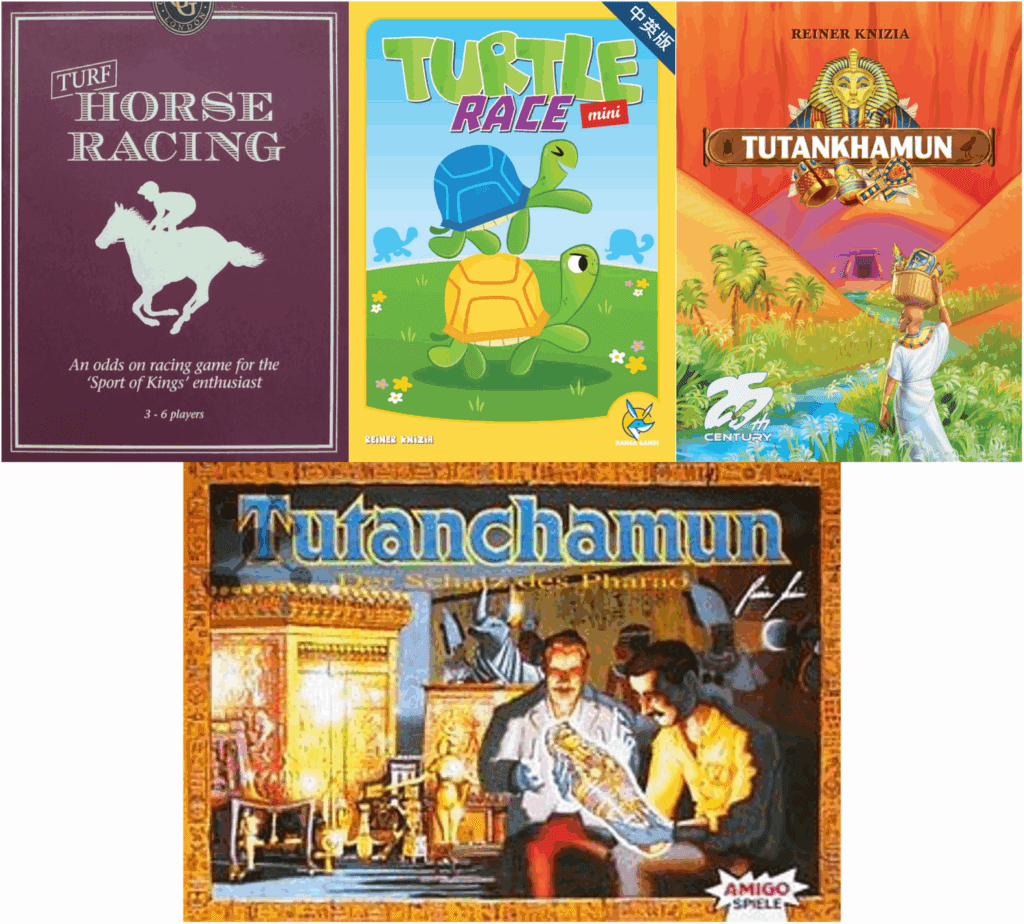
Turtle Race Mini – Based on 2004’s Ribbit, this 2019 release condenses the experience into a much smaller package and ramps up the cuteness. Each player is secretly assigned a tortoise (Fun Fact: all tortoises are turtles but all turtles are not tortoises!) colour at the start and spends the race moving turtles forward and backwards in the rankings, with turtles stacking and carrying all those on their shells with them. A kid’s game, but one that works with the adults playing as well!
Tutankhamen / Tutankhamun – Knizia has long been fascinated by ancient Egypt. 1993’s Tutankhamen was directly inspired by a trip Knizia made to the Munich Museum of Egyptian Art where he saw a map of Egypt with historical civilisations clustered along the Nile. It was redesigned in 2021 as Tutankhamun, published by 25th Century Games (no strangers to Knizia’s Egyptian games themselves). Both the original and redesigned games feature a river of tiles that players move along, claiming tiles to create sets that give points (it’s a tile collection mechanic similar to 2020’s Bites). The new version of the game modifies the scoring, tweaks the two player game and introduces new god powers to help players successfully sail the river Nile.
–
And so ‘T’ terminates. What do you think? Were we tiptop in our trustworthy ‘T’ tastes, only tolerable or was the article a troubling trial and our actions tantamount to treason? What ‘T’ do you take your hat off to? Tell us in the comments below and take a turn through the rest of the Reiner Knizia Alphabet here!


